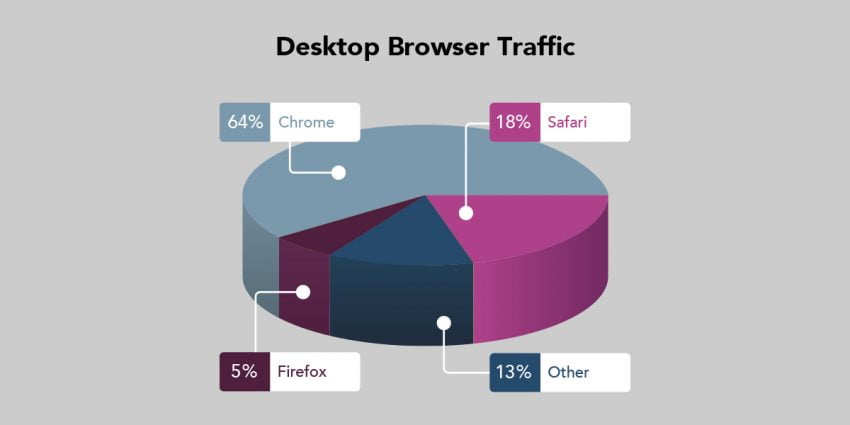In digital advertising, marketers frequently use browser cookies which act as unique identifiers that are assigned to a user, allowing advertising companies to track your internet activity. Cookies are also known for keeping you signed into websites, remembering site preferences that you have previously set, as well as providing you locally relevant content based on your current location. Having this much information collected and tracked within third-party cookies has caused users to ask for more control of their privacy in the past few years, which has ultimately led to the recent privacy changes like the General Data Protection Regulation (GDPR) and the California Consumer Privacy Act (CCPA).
The Future of the Cookie
Google made the announcement on January 14, 2020 that their third-party cookies will be phased out and will no longer be trackable by the year 2022. What many people overlook is that Safari and Firefox have already phased out third-party cookie tracking (Safari 2017, Firefox 2019) within their browsers. Chrome’s decision to phase out third-party cookies will have a massive impact on how marketers will use cookies in the future since Chrome currently makes up 64% of overall desktop browser traffic and 40% mobile traffic. The shift from using third-party cookie data to only being able to utilize first-party cookie data to target users will change advertising as it is today and mold the future of the way we implement digital advertising. The industry of digital advertising is constantly evolving, but this change in third-party data collection will have a massive impact on the integrity of the data that is used to serve ads to targeted audiences.

Digital Advertising in a Cookie-less World
Currently, the environment of digital advertising using third-party cookie data favors publishers as well as advertisers but has had little benefit to consumers. The major web browser corporations who are implementing these changes think that publishers, advertisers, and customers should be considered equal when it comes to collecting user’s data. They also believe that customers should have more control over what personal information publishers and advertisers can have access to. The removal of third party cookies is expected to reduce the overall publisher revenue by an estimated 52% which has many publishers, who rely on third party cookies to target users, in a panic.
Advertisers will also be affected by seeing a significant decrease in the available digital inventory, causing cost to increase and overall reach and frequency to decrease for the remaining available inventory. The ability to attribute conversions throughout the customer journey will also become more challenging as view-through conversion metrics will completely disappear. Digital marketers will be required to implement media strategies that are tailored for their business (or clients), due to this decrease in inventory and increase in the overall cost of inventory. Many advertisers are speculating that there will also be a shift in budget to “older” digital tactics (i.e. contextual advertising, traditional retargeting, first-party call tracking, etc.) as well as more customization of the ad creative so it blends in with the website placements as opposed to creative being customized for the individual user.
How to Surpass your Competition in a Cookie-less World
At Zion & Zion, we are currently preparing our clients for this transition by researching its impact as well as evaluating solutions so they are well equipped for this transition in advance. The largest shift we expect to see in digital advertising is that businesses will begin to take advantage of their first-party data and use it to inform their overall advertising strategy. First-party data is the data you collect from customers or potential customers and can range from your CRM data to the data you collect on your website users based on their behaviors or actions. Generally, we see that many businesses become overwhelmed by the amount of first-party data they have and don’t know where how to efficiently use it to drive their advertising tactics.
The good news is that there is currently a solution in the marketplace that will allow businesses to implement holistic marketing strategies when utilizing the Tealium Consumer Data Platform (CDP.) The Tealium CDP allows businesses to centralize their customer data and make it available to other systems to use within their marketing campaigns, customer service, as well as all customer experience initiatives. What makes the Tealium CDP so unique is their built-in privacy and consent management features paired with their ability to create custom audiences through their AudienceStream functionality. This platform allows you to segment first-party data from the CDP as well as create custom audiences that you can then target within your advertising efforts. Tealium found that 62% of organizations believe that a CDP will be essential for complying with the data privacy regulations by the year 2025, but only 26% of respondents said their current CDP has built-in privacy and consent management features.
By investing in the implementation of Tealium CDP, you will find yourself lightyears ahead of your competitors by complying to future data privacy regulations as well as sidestepping competition by avoiding bidding on the same generalized audiences that are provided by the digital advertising publishers.
Conclusion
Many believe that Chrome’s decision to remove third-party cookies will be the nail in the coffin for the future of all third-party cookies within digital advertising. The impending future without third-party cookies will change the way we advertise to our consumers entirely. There is still time to prepare for this change, but only if we act now. Currently, many publishers as well as advertisers are in a “wait and see” pattern to monitor what Google releases about this change in the coming months. But, waiting for more information will leave them behind their competition. Publishers and advertisers who are not implementing solutions during the next two years will either disappear or be forced to shift their business model away from using third-party cookies.
Advertisers and businesses cannot rely on the advertising publishers to find these solutions and should focus on implementing solutions of their own, like the Tealium CDP, that will make the most of their owned data as well as creating a refined long term marketing strategy to take advantage of the first-party customer data that is already at your fingertips.
And that’s how the third-party cookie crumbles.
